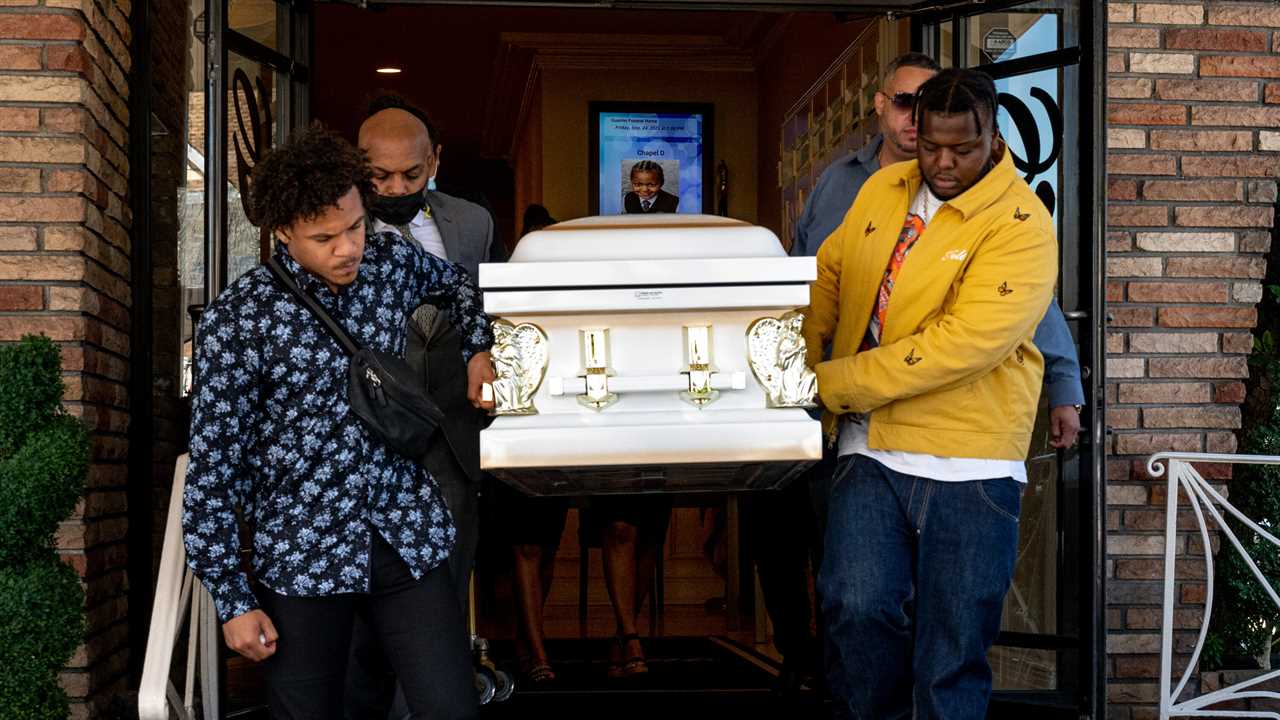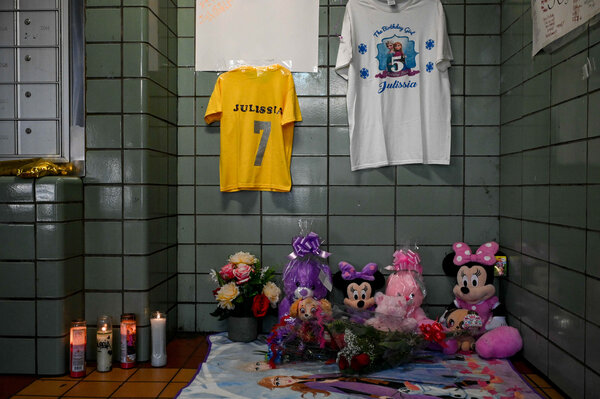
Doctors never examined 4-year-old Jayce Eubanks’s cuts and bruises.
Child welfare workers did not alert the police to 7-year-old Julissia Batties’s black eye.
Investigators closed Aisyn Emerson-Gonzalez’s case despite his swollen eye and a lump on his head.
All three children were beaten to death at home in the closing weeks of this summer, Their deaths were among a string of fatalities involving children who were the subject of warnings to child welfare authorities or the police in New York City.
While the number of homicides of children in the city this year is close to that of recent years, the series of killings has exposed the holes in a multiagency safety net, from social workers to detectives, where a wrong decision could mean the death of a child. In recent weeks, city officials have examined how investigators skipped steps, were slow to follow up or might have closed an abuse case too soon.
Several children died even after their cases had been escalated to the city’s “Instant Response Team,” a task force whose stated mission is to protect children from mistreatment “by ensuring that evidence is gathered in a timely, effective, and coordinated manner.” The medical examiner’s office said that the bodies of three children, including those of Aisyn and Jayce, bore the mix of old and recent injuries known as battered child syndrome.
“I am asking for answers,” Aisyn’s grandmother Gilda Emerson-Celestin said in late September at a funeral home in Brooklyn where Aisyn, 4, lay in a white suit coat, a toy truck placed by his head. “And I’m not getting any answers.”
In March, Aisyn, who lived in Williamsburg, Brooklyn, told investigators he had gotten his injuries from a fall at school. The school said he was not hurt there, but his case was closed after a doctor said the injuries were consistent with an accident, the police said.
A neighbor said that four days before Julissia died, she had reported to the authorities that the child had told her that her mother had given her the black eye. In Harlem, after a 911 caller last March reported hearing screaming and banging involving a child, the police did not knock on doors on the floor where 10-year-old Ayden Wolfe lived.
In response to questions from The New York Times about the missteps, the city said last week that it would make a series of changes to keep closer watch over families that have been the subject of a report of suspected abuse and improve coordination between the police and the city’s child welfare agency, the Administration for Children’s Services.
The changes include appointing a captain to oversee child abuse cases in the police Special Victims Division, effectively reinstituting a position that was eliminated a year ago; requiring home visits by the police in suspected abuse cases when someone in the family has a domestic violence history; and restarting a cross-training program between the Police Department and A.C.S. that the city stopped during the pandemic.
Last week at a City Council hearing, the Special Victims Division commander, Deputy Inspector Michael King, told Council members that an investigator in Jayce’s case had made “a mistake” by not filing a report that would have required officers to visit Jayce’s apartment. He said that going forward, officers will make more unannounced visits before closing cases and that if a child misses a medical appointment, that will also trigger a home visit.
The children’s services commissioner, David A. Hansell, said in a statement that the changes “will better align our expertise with N.Y.P.D.’s capabilities when investigating the most serious abuse cases” and “strengthen our ability to protect children and meet the needs of their families.”
Safe Horizon, the nonprofit that runs centers where children in suspected abuse cases are interviewed and sometimes physically examined, said in a statement that it would increase focus “on which injuries are medically significant” and, at one center, discuss a child’s injuries with a medical team when an exam “cannot happen immediately.”
Child welfare caseworkers in New York City field over 1,000 reports a week of mistreatment and neglect — everything from dirty clothes and chronically missed meals to a broken arm. While child abuse experts say a death is often preceded by increasing violence, it is easier to look back and see how tragedy might have been avoided than to predict when mortal danger lies just ahead.
The child welfare agency, which has stepped up efforts in recent years to keep families together rather than send children to foster care, is under competing pressures: It spends much of its limited resources investigating maltreatment reports, often filed by estranged partners, which can lead to the unnecessary removal of a child from a home, according to lawyers for parents in the system. But if the agency plays down an abuse report, it risks leaving a child in harm’s way.
“Child welfare is the only agency that is expected to have 100 percent success stories,” said Anthony Wells, president of the union that represents the agency’s caseworkers.

Children’s Services officials defended the work of the Instant Response Teams, which were expanded in 2017 with the additions of a coordinator, case managers and liaisons to prosecutors.
“The challenge is that these cases are difficult,” Susan Morley, the children’s services official who oversees the teams, said in an interview last month. “Children are injured in accidents and get bruises — that same bruise if someone pushes the kid can be the same one if the kid trips.”
The officials acknowledged a paradox at the heart of some cases: Their decision to seek a physical exam, which could turn up signs of abuse, is often based on how bad a child’s injuries look; but some injuries, like bleeding on the brain or soft tissue damage, can be invisible.
Agency officials also noted that a medical exam typically requires a guardian’s consent; while a judge can order one, many judges will not if the child has no visible serious injuries, they said.
The city’s changes do not include any increase in the staffing of police child abuse squads, where about 75 detectives, many of them novice detectives known as white shields, collectively handle around 7,000 cases per year.
Michael Osgood, a retired deputy police chief who led the Special Victims Division for eight years and who had pushed his superiors for more resources, said in an interview that few of the unit’s detectives are equipped to handle child abuse cases. “Child abuse homicides develop over months and years, and it takes advanced investigative skills to pierce those cases,” he said.
A spokeswoman for the Police Department, Devora Kaye, responded that Special Victims child abuse investigators are “seasoned and well-rounded.” Many have experience in domestic violence prevention, and some have experience in child welfare, she said.
Mr. Osgood added that the changes announced by the city are not reforms, but renewals of lapsed practices. “They’re saying, ‘Oh, we have to put them back in,’” he said.
Jayce Eubanks’s grandmother Barbara DelValle, 47, said the changes had come too late. “Fix what?” she said. “After all these kids died — now is the fix-up?”
She cited the many cases over the decades in New York City where missed signs preceded a child’s murder and led to shake-ups in child welfare, a list that includes Elisa Izquierdo in 1995, Nixzmary Brown in 2006, Marchella Pierce in 2011 and Zymere Perkins in 2016. “Everything they say sounds great,” Ms. DelValle said, “but I know it’s not going to happen.”
The child welfare agency typically receives and reviews child abuse reports through a state hotline, then assigns the cases believed to be the most serious — about 10 percent — to an instant response team. A caseworker and a patrol officer or Special Victims detective are supposed to visit the child within two hours.
Often, the team brings the family to a Child Advocacy Center run by Safe Horizon. There, caseworkers, detectives, prosecutors, social workers and medical personnel, if available, work together. The idea is to spare a traumatized child the ordeal of several interviews.
After child care workers reported on Aug. 26 that Jayce had a swollen finger and his 5-year-old brother had other injuries, the children were interviewed at a Child Advocacy Center, where both said they were injured horsing around with each other, the police said. The police said that Jayce was given a referral for a medical exam, but never made it to an appointment. Jayce’s grandmother Ms. DelValle said that the family was never told to make an appointment.
Jayce’s A.C.S. case had been closed by the time he died on Sept. 12, a law enforcement official said. An autopsy determined his skull had been fractured some time ago, and he had freshly broken ribs, a perforated stomach and bites on both ears. His mother’s boyfriend, Jerimiah Johnson, 27, was charged with murder.
Jayce’s death came only hours after Aisyn Gonzalez was found dead. No one has been charged yet in his murder, or in Julissia’s.
Two days before Aisyn’s death, 13-month-old Legacy Beauford bled to death of abdominal injuries. He had also been sodomized with a toothbrush, the police said after his death. The police had been dispatched to his apartment four times in May and July after 911 callers reported possible abuse, but found no signs of abuse.
Legacy’s mother, Jessica Melendez, said in an interview that all the 911 calls were unfounded and that her neighbors called the police on her because she often had several children in her apartment — her own and her nieces and nephews — playing loudly and making noise.
Ms. Melendez’s boyfriend, Keishawn Gordon, who was charged with murdering Legacy, told the police he kept squeezing the child because he wouldn’t stop crying, according to a criminal complaint. “He kept throwing up,” Mr. Gordon said. “He was irking me.”
In Ayden Wolfe’s case, officers who went to the floor where a 911 caller reported screaming and banging listened at doors but did not knock on any,tried and failed to reach the 911 caller and left, the police said. Ayden died the next day. A department review of the officers’ actions found that they were appropriate. Ayden’s mother’s boyfriend, Ryan Cato, was charged with his murder.
After Julissia Batties was fatally beaten on Aug. 10, the police said that A.C.S. had not told them about the black eye while she was alive.
There have been 13 homicides against children under the age of 11 so far this year in New York City, just below the full-year average in recent years of about 15.
Some experts feared abuse would fester behind closed doors among families stuck in isolation after lockdown began last year, but Mr. Hansell said this spring that there had been no signs of a spike.
Statistics, though, offer no comfort to loved ones mourning children whose lives ended in unimaginable terror and pain.
On the eve of what would have been Aisyn’s fifth birthday, his great-grandmother Dena Emerson was weeping instead of getting ready to celebrate with him.
“Enough is enough,” she said. “My grandson’s death is not unique. These babies have been abused and killed.”
Title: These Children Were Beaten to Death. Could They Have Been Saved?
Sourced From: www.nytimes.com/2021/10/26/nyregion/child-abuse-reports-deaths-nyc.html
Published Date: Tue, 26 Oct 2021 09:00:25 +0000
Did you miss our previous article...
https://rsssuperfeeds.com/viral-news/the-big-facebook-leak






